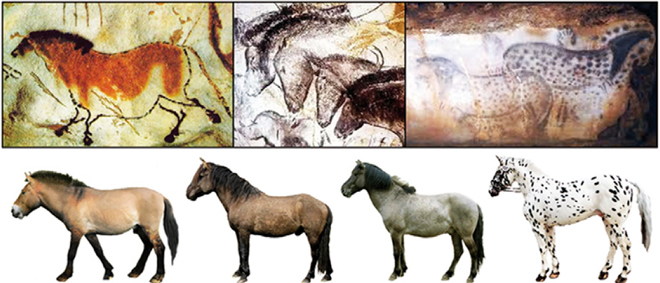We're open daily! View holiday hours
Science News
Spotted Horses
November 9, 2011

We often report here how modern technology brings us closer to answering age-old questions. For years, archeologists have argued whether European cave art, tens of thousands of years old, was more imaginative than realistic. Did the artists depict a fantasy world, like the heavens above, or did they demonstrate what they saw in their everyday lives?
Take wild spotted horses depicted by our ancestors as having a white coat with black spots in cave paintings around 25,000 years ago. Scientists had evidence of bay and black horses, including a 2009 published DNA study of ancient horses dating back as far as 12,000 years ago, but no proof of the dappled horses.
A team of international researchers decided to try older samples—31 pre-domestic horses dating back as far as 35,000 years ago from Siberia, Eastern and Western Europe and the Iberian Peninsula, analyzing bones and teeth specimens from 15 locations.
They found that six of the samples shared a genetic variant called LP that is associated with leopard spotting, providing the first evidence that spotted horses existed at this time. In addition, 18 horses had a bay coat color and seven were black, meaning that all color phenotypes distinguishable in cave paintings—bay, black and spotted—existed in pre-domestic horse populations.
The study was published earlier this week in the Proceedings of the National Academy of Sciences.
“Our results suggest that, at least for wild horses, Paleolithic cave paintings, including the remarkable depictions of spotted horses, were closely rooted in the real-life appearance of animals,” says study co-author Michael Hofreiter.
Archeologist Terry O’Connor concurs. “Our research removes the need for any symbolic explanation of the horses. People drew what they saw, and that gives us greater confidence in understanding Paleolithic depictions of other species as naturalistic illustrations."
Want to learn more? ScienceNOW offers a reason why the LP gene was absent from more recent samples (as studied in the 2009 paper):
As for why the spotted phenotype became more rare after 14,000 years ago, the team points out that some modern horse breeds with two copies of the LP gene suffer from night blindness, which would have made prehistoric horses more vulnerable to predators. The researchers speculate that the gene might have been beneficial during the ice age, when a white spotted coat could serve as camouflage in snowy conditions, but later became rare and disadvantageous until rediscovered by modern horse breeders.
Image: Pruvost et al./PNAS